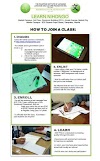El arte y el cine en España y América Latina
The Subjunctive: Forms
(El subjuntivo: formas)
(El subjuntivo: formas)
| The subjunctive is not a verb tense; it's called a "mood". In fact, the subjunctive has various tenses and forms, though fewer than the indicative mood. The 4 subjunctive tenses that we will cover are the present subjunctive, the imperfect (past) subjunctive, the present perfect subjunctive, and the pluperfect subjunctive. |
| Present Subjunctive: Regular -AR verbs | |
| DESCANSAR: to rest | |
| ...que yo descanse | ...que nosotros descansemos |
| ...que tú descanses | (que vosotros descanséis) |
| ...que él/ella/Ud. descanse | ...que ellos/ellas/Uds. descansen |
| Present Subjunctive: Regular -ER and -IR verbs | |
| COMPRENDER: to understand | |
| ...que yo comprenda | ...que nosotros comprendamos |
| ...que tú comprendas | (...que vosotros comprendáis) |
| ...que él/ella/Ud. comprenda | ...que ellos/ellas/Uds. comprendan |
Notes
1. The verbs that have irregular "yo" forms in the present indicative are also irregular in the present subjunctive. The rule for most verbs is to drop the -o of the "yo" form; what is left is the stem that the subjunctive endings are added to. For the verb hacer, the "yo" form is hago, so the stem is hag-:
3. The verbs that have stem changes in the present indicative have the same stem changes in the present subjunctive. However, the stem changing verbs ending in -ir, including pedir, mentir, seguir, sentir, vestir, dormir, and many others, have slightly irregular nosotros forms. Instead of having the regular stem vowel in the nosotros form, the verbs with an e stem vowel have an i, and the verbs with an o stem vowel have a u. Here are the examples of sentir and dormir:
|
| Imperfect Subjunctive: Regular -AR verbs | |
| DESCANSAR: to rest | |
| ...que yo descansara | ...que nosotros descansáramos |
| ...que tú descansaras | (que vosotros descansarais) |
| ...que él/ella/Ud. descansara | ...que ellos/ellas/Uds. descansaran |
| Imperfect Subjunctive: Regular -ER and -IR verbs | |
| VIVIR: to understand | |
| ...que yo viviera | ...que nosotros viviéramos |
| ...que tú vivieras | (...que vosotros vivierais) |
| ...que él/ella/Ud. viviera | ...que ellos/ellas/Uds. vivieran |
Notes
1. The stem of the imperfect subjunctive is derived from the 3rd person plural (ellos/as) form of the preterite. This means that if a verb is irregular in the preterite forms, it will have the same irregularity in the imperfect subjunctive. Two examples are decir (pret. dijeron) and seguir (pret. siguieron):
|
| Present Perfect Subjunctive | |
| The present perfect subjunctive is formed with the present subjunctive conjugation of the verb haber plus the past participle, which for -ar verbs ends in -ado and for -er and -ir verbs ends in -ido. You can review the irregular past participles [here]. Here is the present perfect subjunctive of descansar: | |
| ...que yo haya descansado | ...que nosotros hayamos descansado |
| ...que tú hayas descansado | (que vosotros hayais descansado) |
| ...que él/ella/Ud. haya descansado | ...que ellos/as/Uds. hayan descansado |
| Pluperfect Subjunctive | |
| The pluperfect subjunctive is formed with the imperfect subjunctive conjugation of the verb haber plus the past participle. Here is the pluperfect subjunctive of descansar: | |
| ...que yo hubiera descansado | ...que nosotros hubiéramos descansado |
| ...que tú hubieras descansado | (que vosotros hubierais descansado) |
| ...que él hubiera descansado | ...que ellas hubieran descansado |
The Subjunctive Used to
Indicate Doubt
(El subjuntivo para indicar duda)
(El subjuntivo para indicar duda)
|
One
use of the subjunctive in Spanish is to indicate doubt or uncertainty. There
are many phrases and verbs that are used with the subjunctive in this
context. Some of the most common are:
dudar
que...
es dudable que... no es cierto que... no es obvio que... no es seguro que... no significar que...
A
related use of the subjunctive is to indicate possibility or probability
(both of which still indicate some degree of uncertainty). Here are some
common phrases and verbs indicating possibility or probability:
es
imposible que...
es improbable que... es posible que... es probable que... puede ser que...
|
|
Notes
1.
Most of the time, the subjunctive is used in clauses or phrases beginning
with que. However, the subjunctive can also be used after words
like quizás and tal vez (maybe) and after
adverbs like posiblemente and probablemente:
Using the subjuntive in these cases
generally indicates a greater degree of doubt about the statement.
2. Phrases and verbs indicating
personal knowledge or opinion generally do not take the subjunctive. For
example, the subjunctive is not used after pensar que, creer
que, suponer que, parecer que, saber que,
or after es cierto que and es verdad que:
3. The subjunctive is used
after no pensar que, no creer que, no suponer
que and no parecer que:
|






0 Comments